Abstract
The hypothesis that the autistic child's impairment in social relatedness stems in part from underlying deficits in self-recognition was explored. Fifteen autistic children ranging from 4 to 6 years of age were assessed for visual self-recognition ability, as well as for skills in two cognitive areas that are believed to be related to the development of self-recognition — object permanence and gestural imitation. It was found that 13 of 15 autistic children showed evidence of self-recognition. The two autistic children who lacked self-recognition were the only two children to perform poorly on the object permanence tasks, which suggests that these two cognitive domains may be closely linked in development. In contrast, there appeared to be no consistent relationship between motor imitation ability and self-recognition. It was concluded that the autistic child's social deficits are not due to a basic lack of differentiation between self and other.
Similar content being viewed by others
References
Amsterdam, B. K. (1972). Mirror self-image reactions before age two.Developmental Psychology, 5, 297–305.
Baldwin, J. M. (1973).Social and ethical interpretations of mental development. New York: Arno. (Original work published 1899).
Bartak, L., Rutter, M., & Cox, A. (1975). A comparative study of infantile autism and specific developmental receptive language disorder. 1. The children.British Journal of Psychiatry, 126, 127–145.
Bertenthal, B. I., & Fischer, K. W. (1978). Development of self-recognition in the infant.Developmental Psychology, 14, 44–50.
Curcio, F. (1978). Sensorimotor functioning and communication in mute autistic children.Journal of Autism and Childhood Schizophrenia, 8, 281–292.
Dawson, G. & Adams, A. (1984). Imitation and social responsiveness in autistic children.Journal of Abnormal Child Psychology, 12, 209–226.
DeMyer, M. K., Alpern, G. D., Barton, S., DeMyer, W. E., Churchill, D. W., Hingtgen, J. N., Bryson, G. Q., Pontius, W., & Kimberlin, C. (1972). Imitation in autistic, early schizophrenic and nonpsychotic subnormal children.Journal of Autism and Childhood Schizophrenia, 2, 264–287.
Dixon, J. C. (1957). Development of self-recognition.Journal of Genetic Psychology, 91, 251–256.
Fraiberg, S., & Adelson, E. (1975). Self representation in language and play: Observations of blind children. In E. H. Lenneberg & E. Lenneberg (Eds.),Foundations of language development: A multidisciplinary approach (Vol. 2, pp. 177–192). New York: Academic Press.
Gallup, G. G., Jr. (1970). Chimpanzees: Self-recognition.Science, 167, 86–87.
Goldfarb, W. (1963). Self-awareness in schizophrenic children.Archives of General Psychiatry, 8, 63–76.
Hammes, J. G. W., & Langdell, T. (1981). Precursors of symbol formation and childhood autism.Journal of Autism and Developmental Disorders, 11, 331–346.
Lewis, M., & Brooks-Gunn, J. (1979).Social cognition and the acquisition of self, New York: Plenum Press.
Meltzoff, A. N. (1981). Imitation, intermodal co-ordination and representation in early infancy. In G. Butterworth (Ed.),Infancy and epistemology. Brighton, England: Harvester Press.
Meltzoff, A. N., & Moore, M. K. (1977). Imitation of facial and manual gestures by human neonates.Science, 198, 75–78.
Merleau-Ponty, M. (1964).The primacy of perception. Chicago: Northwestern University Press.
Neuman, C. J., & Hill, S. D. (1978). Self-recognition and stimulus preference in autistic children.Developmental Psychobiology, 11, 571–578.
Ornitz, E. M. (In press). The functional neuroanatomy of infantile autism.International Journal of Neuroscience.
Ornitz, E. M., & Ritvo, E. R. (1968). Perceptual inconstancy in early infantile autism.Archives of General Psychiatry, 18, 76–98.
Papoušek, H., & Papoušek, M. (1974). Mirror-image and self-recognition in young human infants: I. A new method of experimental analysis.Developmental Psychobiology, 7, 149–157.
Schopler, E., Reichler, R. J., DeVellis, R. F., & Daly, K. (1980). Toward objective classification of childhood autism: Childhood Autism Rating Scale (CARS).Journal of Autism and Developmental Disorders, 10, 91–103.
Schulman, A. H., & Kaplowitz, C. (1977). Mirror-image response during the first two years of life.Developmental Psychobiology, 10, 133–142.
Ricks, D. M., & Wing, L. (1975). Language, communication, and the use of symbols in normal and autistic children.Journal of Autism and Childhood Schizophrenia, 5, 191–221.
Riguet, C. B., Taylor, N. D., Benaroya, S., & Klein, L. S. (1981). Symbolic play in autistic, Down's, and normal children of equivalent mental age.Journal of Autism and Developmental Disorders, 4, 439–448.
Ungerer, J. A., & Sigman, M. (1981). Symbolic play and language comprehension in autistic children.Journal of the American Academy of Child Psychiatry, 20, 318–337.
Uzgiris, I. C., & Hunt, J. McV. (1975).Assessment in infancy. Urbana: University of Illinois Press.
Wing, L. (1981). Language, social, and cognitive impairments in autism and severe mental retardation.Journal of Autism and Developmental Disorders, 11, 31–44.
Author information
Authors and Affiliations
Additional information
This research was funded by the University of North Carolina Research Council. Part of the data presented here were from Fawn McKissick's undergraduate honors thesis from the University of North Carolina at Chapel Hill. We express our sincere appreciation to the autistic children who participated in the study, and to their parents, and to the staff of the TEACCH Division, Department of Psychiatry, University of North Carolina, for their assistance and cooperation. We would also like to thank several persons for their help in data collecting and coding: Karen Cotten, Pete Giordano, Vickie Hall, Lee Hendrix, Shari Jernigan, Kevin Lumley, Cindy Seagroves, Sheryl Solomon, Kathy Stetson, and Jeannie Teasley. Mary Lynn Eckert provided editorial and secretarial support. Dr. Robert Cairns made helpful comments on this paper.
Rights and permissions
About this article
Cite this article
Dawson, G., McKissick, F.C. Self-recognition in autistic children. J Autism Dev Disord 14, 383–394 (1984). https://doi.org/10.1007/BF02409829
Issue Date:
DOI: https://doi.org/10.1007/BF02409829




